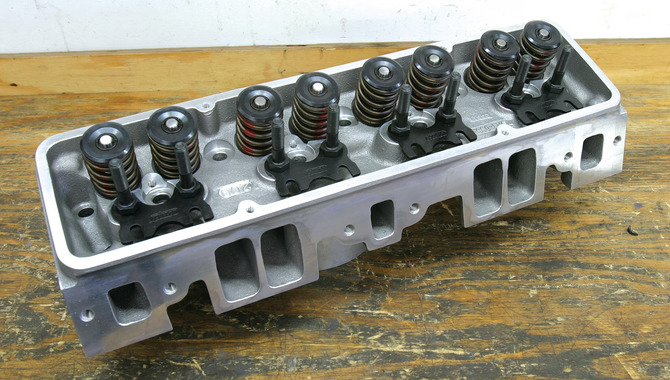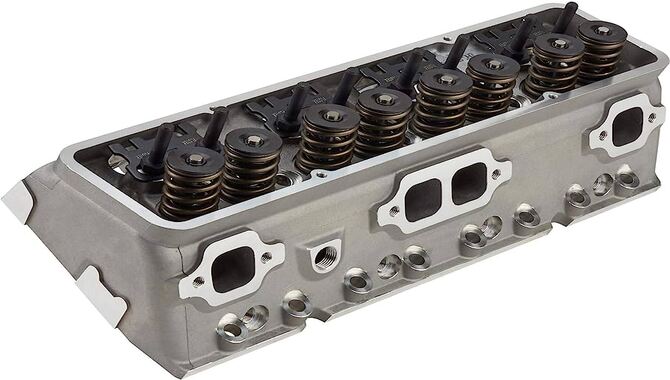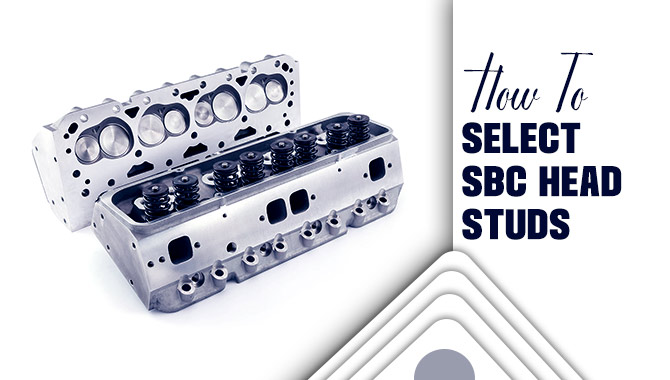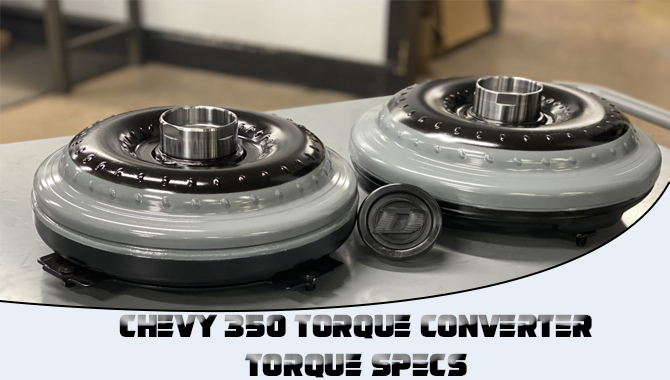Upgrading SBC (Small Block Chevy) heads is a popular and cost-effective way to boost engine performance. Whether you’re a seasoned mechanic or a beginner, the process can be daunting without the right guidance.
That’s where this Pro Guide comes in. We’ll take you through the steps to upgrade your SBC heads to achieve maximum performance gains. We’ll cover everything from selecting the right heads to installing and tuning them for optimal performance.
Choosing the right SBC heads can be a daunting task, as there are countless options available on the market. We’ll help you navigate through the specs and features of each head to make an informed decision for your engine. Additionally, we’ll discuss the different types of valve train components available and how to upgrade SBC heads for Performance.

What Is Upgrading SBC Heads For Performance?
Upgrading SBC (Small Block Chevy) heads for performance is a popular modification that many car enthusiasts undertake to improve their vehicles’ power and overall performance.
The heads are an essential component of the engine, and upgrading them can significantly improve horsepower, torque, and overall engine efficiency. Performance upgrades typically involve installing aftermarket heads designed to improve airflow, combustion, and valve lift.
How To Upgrade SBC Heads For Performance – On Step By Step

Upgrading the SBC heads is a crucial step for improving the performance of your engine. Here is a step-by-step guide on How to upgrade SBC heads for Performance.
Firstly: You must choose the right cylinder heads matching your engine and driving style. You can opt for aftermarket heads with larger valves, better port design, and improved flow rates.
Secondly: You must check the block’s deck surface to ensure it is flat and even. Any warpage can lead to head gasket failure and compression loss.
Thirdly: You need to install new head gaskets and torque the bolts for the heads in sequence to avoid any uneven pressure. Then, you can install new rocker arms, pushrods, and valve springs that match the specifications of your new cylinder heads.
Fourthly: You must set the valve lash, cam timing, and ignition timing according to the manufacturer’s instructions.
Fifthly: You need to properly break in the engine and tune it for optimal performance.
Types Of SBC Heads
When it comes to building a small-block Chevy engine, choosing the right cylinder head is crucial. Several types of SBC heads are available, each with unique features and benefits.
The most common types include,
- Stock
- Vortec
- Aftermarket cast iron
- Aluminum heads
- Stock heads are the most basic and affordable option but have limited performance capabilities.
- Vortec heads, on the other hand, offer better airflow and combustion efficiency, making them ideal for high-performance applications.
- Aftermarket cast iron heads are designed to improve airflow and increase horsepower and torque. They are typically stronger and more durable than stock heads, making them suitable for racing and heavy-duty applications.
- Another popular option is lightweight aluminum heads, which offer excellent heat dissipation. They also feature better flow characteristics than cast iron heads, resulting in improved performance.
Ultimately, the right type of SBC head depends on your specific needs and budget.
Choosing The Right SBC Head For Your Build

Choosing the right Single Board Computer (SBC) head for your build is crucial to ensure optimal performance and compatibility with your project requirements. An SBC head, or the central processing unit (CPU), serves as the brain of the SBC and determines its processing power and capabilities.
When selecting an SBC head, consider the following factors:
Processing Power: The CPU’s clock speed and the number of cores directly impact the SBC’s ability to handle tasks efficiently.
Architecture: Different SBCs use various CPU architectures, such as ARM or x86. ARM-based CPUs are energy-efficient and commonly found in many SBCs, offering excellent support for embedded and IoT projects.
Compatibility: Ensure that the SBC head is compatible with the specific SBC board you intend to use.
Connectivity: Consider the connectivity options required for your project.
Power Consumption: If power efficiency is a priority, select an SBC head that consumes low power while still providing adequate processing power for your application.
Cost: Determine your budget and find an SBC head that balances price and performance well.
Remember to thoroughly research and compare different SBC heads before deciding. Read reviews, consult online communities, and consider the experiences and recommendations of others who have used similar setups.
Carburetor And Fuel Injection Upgrades
Carburetor and fuel injection upgrades are two popular modifications that car enthusiasts often perform to improve their vehicle’s performance. The Carburetor upgrades involve replacing the stock carburetor with a larger and more efficient one, which can provide better fuel economy and increased horsepower.
On the other hand, fuel injection upgrades involve replacing the stock fuel injection system with a more advanced one that can provide better fuel efficiency and more precise fuel delivery. Both of these upgrades can significantly improve a car’s performance, but they require different levels of expertise and skill to install properly.
Carburetor upgrades are generally easier to install and require less technical knowledge than fuel injection upgrades. However, they are also less precise and can require more frequent adjustments to maintain optimal performance.
Cooling System Upgrade
If you’re looking to improve your vehicle’s performance, upgrading the cooling system is a great place to start. A cooling system upgrade can help regulate your engine’s temperature, preventing overheating and improving overall efficiency.
There are a variety of different components that make up a cooling system, including the radiator, water pump, thermostat, and hoses. By upgrading any or all of these components, you can significantly improve your vehicle’s overall performance and reliability.
For example, a high-performance radiator can help dissipate heat more effectively, while a more powerful water pump can increase the flow of coolant through the system.
Assembling The Upgrade SBC Head


Assembling the upgraded SBC head can be daunting, but it can be done efficiently with the right tools and instructions. The first step is to clean all the parts and ensure they are debris-free.
After cleaning, place the pushrods, lifters, and rocker’s arms into their respective positions. It is essential to ensure that the lifters are correctly positioned, and the pushrods are fitted correctly to avoid any damage to the engine.
The next step is to install the pushrod guide plates and cylinder head gaskets, followed by the cylinder heads. Tighten the cylinder head bolts to their recommended torque settings, taking care not to over-torque them.
After tightening the bolts, install the intake manifold and the valve covers. It is essential to ensure all the bolts are tightened to their recommended torque settings to avoid any leaks or damage to the engine.
Maintenance And Care Of Upgraded SBC Heads
Maintaining and caring for your upgraded SBC heads is crucial to ensure their longevity and optimal performance. Regular maintenance can help prevent costly repairs and replacements down the line. One of the most important things to consider is proper lubrication.
Make sure to use high-quality oil and change it regularly to keep your engine running smoothly. It is also important to keep an eye on the coolant level and ensure that the radiator and hoses are in good condition. Overheating can cause serious damage to your engine and should be avoided at all costs.
Another important aspect of caring for your upgraded SBC heads is checking for any signs of wear or damage. Inspect the valve springs, rocker arms, and pushrods regularly to ensure everything is in good working order.
It is also important to check and adjust the valve clearances if necessary. If you notice any unusual noises or issues with your engine, it is important to address them immediately to prevent further damage.
Conclusion
How to upgrade SBC heads for Performance requires careful consideration and planning. Following the steps outlined in this guide, you can select the appropriate components, perform the necessary modifications, and ultimately achieve significant gains in horsepower and torque.
However, it’s important to remember that this process can be complex and may require the help of a professional mechanic or engine builder. With the right approach and attention to detail, upgrading your SBC heads can unlock your engine’s true potential and deliver an exhilarating and reliable driving experience.
FAQ
1.Why Should I Upgrade My SBC Heads?
Ans: Upgrading the heads can significantly enhance the engine’s power and efficiency by improving airflow, combustion, and overall performance.
2.Can I Perform These Upgrades Myself?
Ans: While enthusiasts can do some basic modifications, certain upgrades may require professional expertise, especially for precision work like porting and valve installation. Seek guidance if you’re not confident in your abilities.
3.How Do I Choose The Right Heads For My Needs?
Ans: Consider factors such as intended use, budget, and desired power levels. Research various head options, consult experts, and select heads matching your requirements.
4.Are There Any Other Considerations?
Ans: Yes, a comprehensive upgrade involves ensuring compatibility with the rest of the engine components, such as the intake manifold and camshaft. Balancing the entire setup is crucial for optimal performance.
5.What Performance Gains Can I Expect?
Ans: Performance gains vary depending on the upgrades, including increased horsepower, torque, throttle response, and improved fuel efficiency.


![SBC ARP Head Bolt Torque Specs [Easy Steps & Tips]](https://accuratepicker.com/wp-content/themes/Extra/images/post-format-thumb-text.svg)


